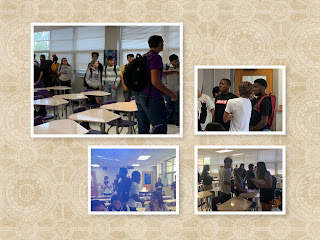You walk into the weekly math team meeting. Ideally, this is where teachers gather to talk about student learning. The conversation barely gets started when one person says, "the problem is these kids don't do their homework." Next thing you know, a 15 minute gripe session has transpired, with teachers concluding that "they [the students] don't know math because they don't do homework." This could not be any farther from the truth as saying the sky is green!
You say it does sound familiar? Ohh, but you don't even teach math and other teachers you know say the same thing. Well, it is time for this conversation to end no matter what subject you teach. "Home"work is not the source of why students are not learning; "home"work is a practice that, in its current implementation, is only able to be accomplished by students with access to resources - i.e. mainly white middle and upper class. Yes, I said it (in my best Dave Chappelle voice). Let's look at why and how we need to reimagine homework.
Why students not completing the homework is not the problem
I am known to be straightforward and honest. I am delicate when I can be or even humorous. In this instance, there is no way to be delicate or humourous. I have to tell you that we, the teachers, are the problem. We are not only the problem but we have done some of the greatest harm as we hold onto misinformed beliefs and biases. Let's break down how we are the problem before we work to change it.Problem #1: Assigning homework at the wrong time
Homework is not assigned everyday and less frequency doesn't mean it is the right time either. Classroom Instruction that Works by Dean and others states, one purpose of homework is to practice on content already learned. None of the versions of their book says that homework is to practice content that you told them about. Explaining something for most of the hour and then having students interact for a minimum amount of time does not mean they learned anything. Homework is NOT where students learn, it is where they strengthen their learning.Problem #2: The type of homework is all wrong
A copy of a handout or complete questions blah blah on page blah blah is the standard homework given to students. Although it has been an awful practice for decades, we keep it up. Students are not widgets. They come with different lenses that unfortunately we reduce to labels like special education or we are blinded by our bias and miss the strengths in their ethnicities.Problem #3: The homework requires help
This is sometimes something that is a byproduct of the first two problems but even if we are mindful of the first two we can still possibly fall into this problem. It is where the student does not have multiple ways to access the work so that they would not need help from anyone else. It is no longer homework if they need help from family or friends. It is supposed to be an independent exercise."Home"work Reimagined
The inequities in this practice have plagued me since I entered the profession. Well, the entire educational system has plagued me to be honest but let's focus on this one. Let's review some simple things you can do to help kids learn instead of blaming them for not learning.Center Instruction on Students
Lectures are not bad but it is a method that only works if the people who are listening are interested. Sitting quietly and listening for hours on end was never a great practice. It just seemed to work because the audience was motivated by a particular goal such as a diploma or degree. They figured out a way to fit the method even though the method never worked for them. Lectures only make the person who is talking know more. Some ways to move student to the center of instruction is through thinking routines, protocols and collaborative strategies.Focus on Thinking
I love the way Classroom Instruction that Works shares how "homework has two purposes:- some assignments may be practicing or elaborating on vocabulary or other knowledge and skills already learned in school, whereas
- others will focus on preparing students for new information or elaborate on information that was already introduced."
Can this be accomplished by a handout from your textbook? Yes, but it usually is not designed with your students in mind. I love assigning homework where my students just need to think about something especially with no right or wrong answer. It also honors their "home" since they may have a variety of commitments going on when they are there. One example of this from my Algebra I and Algebra II math class is that students can think about all the ways in life we can have two or more lines while working or interacting with family.
Uplift the Family
Learning is relationship based. Before students ever come to school, they learned with their family. Regardless of the family situation, they are being shaped together. Educators are not just educating their students, they are educating families directly and indirectly. It is time to not do this in a default way but to be intentional. Start with getting to know your families. Students can tell you a lot as well as a home visit. Events designed with the family in mind is another way to get to know them. Use this information to alter your classroom instruction and the work they do outside of class.































